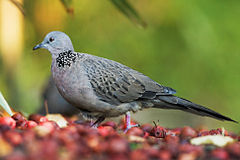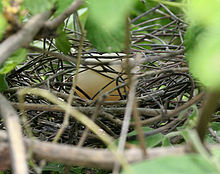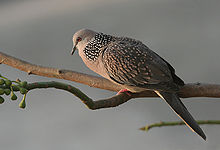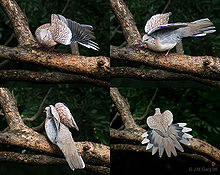- Spotted Dove
-
Spotted Dove 
At Austins Ferry, Tasmania Conservation status Scientific classification Kingdom: Animalia Phylum: Chordata Class: Aves Order: Columbiformes Family: Columbidae Genus: Spilopelia (see text) Species: S. chinensis Binomial name Spilopelia chinensis
(Scopoli, 1768)Subspecies - S. c. chinensis
- S. c. hainana
- S. c. suratensis
- S. c. tigrina
- S. c. formosae (this one might be invalid)
Synonyms Streptopelia chinensis (see text)
Stigmatopelia chinensis (see text)The Spotted Dove (Spilopelia chinensis), also known as the Spotted Turtle Dove, is a pigeon which is a resident breeding bird in the Indian Subcontinent including India, Pakistan, Nepal and Sri Lanka east to southern Tibet and Southeast Asia. It is also known as the Chinese Dove, Mountain Dove, or Lace-necked Dove.[2]
As it possesses numeous apomorphies separating it from the "typical" turtle- and collared doves (Streptopelia sensu stricto), it is here separated in the genus proposed for it, Spilopelia. DNA sequence data is quite in line with such a treatment, but would favor including the Spotted Dove's closest living relative (Laughing Dove, S. senegalensis) in Spilopelia also. While these two species are each rather autapomorphic in appearance, their behavior and molecular data support treating them as a small and distinct genus, perhaps originating on the northern Mascarene Plateau (now submerged) or in in the lands around the northern Arabian Sea, which regions are between their present-day ranges.
Contents
Range
It is a widespread species in open woodland, farmland and habitation over a good deal of its natural range, and this successful bird has also been introduced to the U.S. to Hawaii and Southern California. Other countries it has been introduced to include Singapore, the Philippines, northern Indonesia, Bangladesh, Australia and New Zealand. In Australia, it was introduced in Melbourne in the 1860s and has since spread, often replacing native doves. In Australia, they are now found in streets, parks, gardens, agricultural areas and tropical scrubs, from Hobart, Tasmania, to Cooktown, Queensland, to Port Lincoln, South Australia. They can also be seen in Perth, Pemberton, Kalgoorlie and Esperance, in Western Australia. The species' range is expanding.
Characteristic
This species builds a very simple stick nest and lays two white, glossy eggs. Like most pigeons, spotted doves appear to mate for life and share some parental duties, including feeding infants 'pigeons' milk' which both parents produce in the crop. When fledged, young are darker than juveniles. In Hawaii, they breed all year round, as do all three other introduced species of doves. In southern Australia, they breed mostly from September to January, and in the north in Autumn. Its flight is quick, with the regular beats and an occasional sharp flick of the wings which are characteristic of doves in general.
Spotted Dove is long-tailed and slim,ranging in length from 28 to 32 centimetres (11.2 to 12.8 inches). Its back, wings and tail are pale brown and buff. In flight, it shows blackish flight feathers bordered on the inner edge with pale grey, and a flash of white tail feather on either side. Sexes are similar, but juveniles are duller than adults and do not acquire the neck spots until they are mature. The head and underparts are pinkish, shading to pale grey on the face and lower belly. There is a charachteristic black neck patch finely spotted with white. The legs are dark pink.
The call is a low and gentle two or three syllable coo-coo-croo, with the emphasis on last note. The call occasionally is "coo-coo krrroo, krook!"
Behaviour
Spotted Doves eat grass seeds, grains and other vegetation. They are fairly terrestrial, foraging on the ground in grasslands and cultivation. There have been some reports of eating insects. In climates such as Hawaii, it breeds all year round, with nests commonly found in trees, edges of buildings or even on the ground. There, it lives in close association with housing, parks and other human activities, primarily because of associated seed-bearing landscaping from introduced vegetation, and irrigation.
Like some other doves in this genus, they are not particularly gregarious, and are usually alone, or in pairs. It is calm, but leery of humans and other animals. In mixed flocks of pigeons, spotted doves and zebra doves, the spotted doves will be the last to come to the food source and will occupy the extreme outer edge of the group; they will be the first to flush to flight due to any noise, motion, or unease. Flight patterns are similar to the Crested Pigeon. Upon landing, birds tilt their tail upwards. Males on display obtain a steep angle and circle down displaying their wings and tail by spreading them out. Like pigeons and other doves, males typically follow their mates with coos and calls throughout the day.
References
- ^ BirdLife International (2004). Streptopelia chinensis. 2006. IUCN Red List of Threatened Species. IUCN 2006. www.iucnredlist.org. Retrieved on 9 May 2006. Database entry includes justification for why this species is of least concern
- ^ "Spotted Dove (Strptopelia chinensis)". Explore Biodiversity. http://www.explorebiodiversity.com/Hawaii/BIRDS/Birds/Spotted%20Dove.htm. Retrieved 2010-05-26.
- Grimmett: Birds of India. Inskipp and Inskipp, ISBN
- Pizzey and Knight: Field Guide to the Birds of Australia. Angus & Robertson, ISBN
- Trounsen and Trounsen: Australian Birds: A Concise Photographic Field Guide. Cameron House. ISBN.
External links
Categories:- IUCN Red List least concern species
- Streptopelia
- Birds of the United States
- Birds of China
- Birds of Pakistan
- Birds of Sri Lanka
- Birds of Australia
- Birds of New Zealand
- Birds of Indonesia
- Birds of Southeast Asia
- Birds of North America
- Birds of Tasmania
- Introduced birds of Hawaii
- Urban animals
Wikimedia Foundation. 2010.




